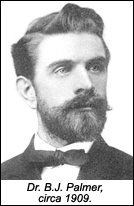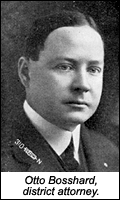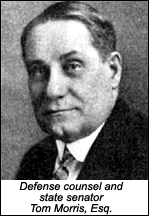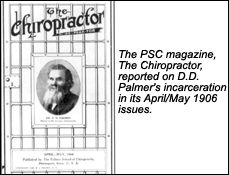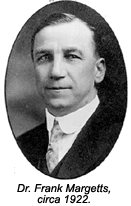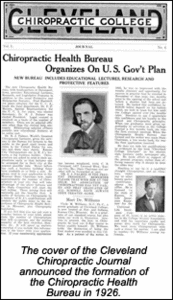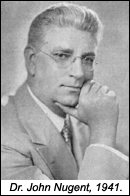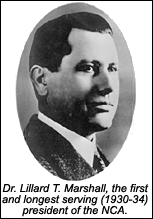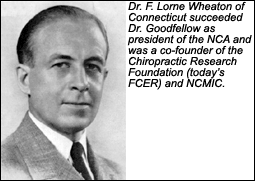The UCA was born of necessity: to provide legal defense services to chiropractors, who seemed destined for grief at the hands of organized, political medicine. Several chiropractors had already undergone prosecution for unlicensed practice,7 including D.D. Palmer, whose conviction in Davenport in the spring of 19063 foreshadowed thousands of cases to come. The UCA was not the first attempt to establish a national organization; that distinction appears to belong to activists in Minnesota in 1905, who sought a bill to license chiropractors at that time. Their efforts were thwarted by D.D., who encouraged Governor Johnson to veto the statute, which he did.4
The UCA's legal defense strategy for the next several decades was mapped out in the courtroom in LaCrosse, Wisconsin, in the trial of PSC alumnus Shegetaro Morikubo, DC, a founding member of the UCA. Acquitted of the charge of practicing osteopathy without a license, credit for his defense goes to the attorney (Tom Morris) hired by the secretary of the UCA, B.J. Palmer. Morris continued as chief legal counsel of the national society until his death in 1928; along the way, he served a term as lieutenant governor of Wisconsin.
The UCA's activities quickly expanded beyond legal services. An annual convention was held, usually in Davenport, Iowa, in conjunction with the homecoming of the PSC, and the school magazine, The Chiropractor, became the official publication of the society. Although Palmer and Morris were unenthusiastic about the prospect of chiropractic licensing laws, by 1919, they had organized several meetings of delegates from the newly established boards of chiropractic examiners (BCEs) in several states. Cooperative action in seeking to standardize chiropractic statute was not forthcoming, however, owing in part to fear that Palmer and UCA were seeking to dominate the profession.
Part of the basis for these apprehensions was the UCA introduction of its "Cleaning House" policy, which demanded that state associations purge "mixers" from their ranks, or the UCA would organize a competing state society in those jurisdictions that defied its edict. In fact, UCA did this in several states (e.g., Nebraska, New York), and Palmer reaped the animosity of a great many in the profession. B.J.'s effort to establish a National Board of Chiropractic Examiners (NBCE), circa 1922, was also unsuccessful, again attributable to concern that he and the UCA sought to control the profession. Today's NBCE is the fourth so-named organization.6
By 1922, dissatisfaction with Palmer and the policies of the UCA was so great that a rival national organization, the American Chiropractic Association (at least the third organization to adopt this title), was established.1 This ACA's longest serving president (1923-1929), Frank R. Margetts, was an ordained Baptist minister, an 1893 alumnus of the Chicago College of Law,6 and a 1920 graduate of the National College.
When Palmer introduced the neurocalometer (NCM) in 1924, a device he claimed would save chiropractic for straight chiropractic and force broad-scope practitioners into line with UCA policies,7 Margetts stood in opposition8 and rallied many former UCA members to the cause of the ACA. After resigning his presidency in 1929, he worked behind the scenes to bring about the merger of the ACA and the UCA (which, by that time, had veered away from Palmer's policies). Margetts was long remembered for the many presentations he made before state legislatures on behalf of the profession.
The NCM created so much animosity in the profession9 that Palmer failed in his bid for re-election as secretary of the UCA in August 1926. The following month, he established the Chiropractic Health Bureau (CHB), renamed the International Chiropractors' Association (ICA) in 1940-1941. The Davenport leader would continue as president of this rival national society until his death in 1961. Along the way, B.J. and the CHB/ICA championed the cause of "pure, straight and unadulterated" chiropractic and stood in opposition to the standardization and improvements in chiropractic education.
The year 1926 is also noteworthy for the formation of the International Congress of Chiropractic Examining Boards (ICCEB), the earliest organizational predecessor of today's Federation of Chiropractic Licensing Boards (FCLB). Established in Kansas City by an assembly of delegates of various BCEs, the ICCEB was renamed the Council of State Chiropractic Examining Boards of the United States and Canada (COSCEB) in 1934, and renamed again (as FCLB) in 1972. This organization was the spearhead for the sustained efforts to upgrade chiropractic colleges, commencing in the mid-1930s. John J. Nugent, DC, remembered alternately as the "Abraham Flexner of chiropractic" or as the "Antichrist of chiropractic," headed this organization in its push for educational improvements,10 and resigned his presidency of COSCEB in 1941 to assume the role of director of education for the National Chiropractic Association (NCA). In 1947, Nugent organized the NCA's Council on Education, the earliest ancestor of today's Council on Chiropractic Education (CCE). Although he was forced into early retirement in 1959, Nugent lived to see his dream fulfilled when the CCE was recognized by the federal government in 1974.11
Today's ACA (the fifth so-named organization) is the successor to the national membership society established in 1930 by the merger of the third ACA and the UCA.2,12 The NCA (1930-1963) was seen by many in the profession as the "unity movement" at its inception, and brought together many individuals who had previously feuded with one another. Lillard T. Marshall, DC, of the Kentucky BCE, was the NCA's founding president, honored as a pioneer for decades to come.
[Editor's note: Complete references will appear in part two of this article.]
Joseph Keating Jr., PhD
Phoenix Arizona
Click here for previous articles by Joseph Keating Jr., PhD.






